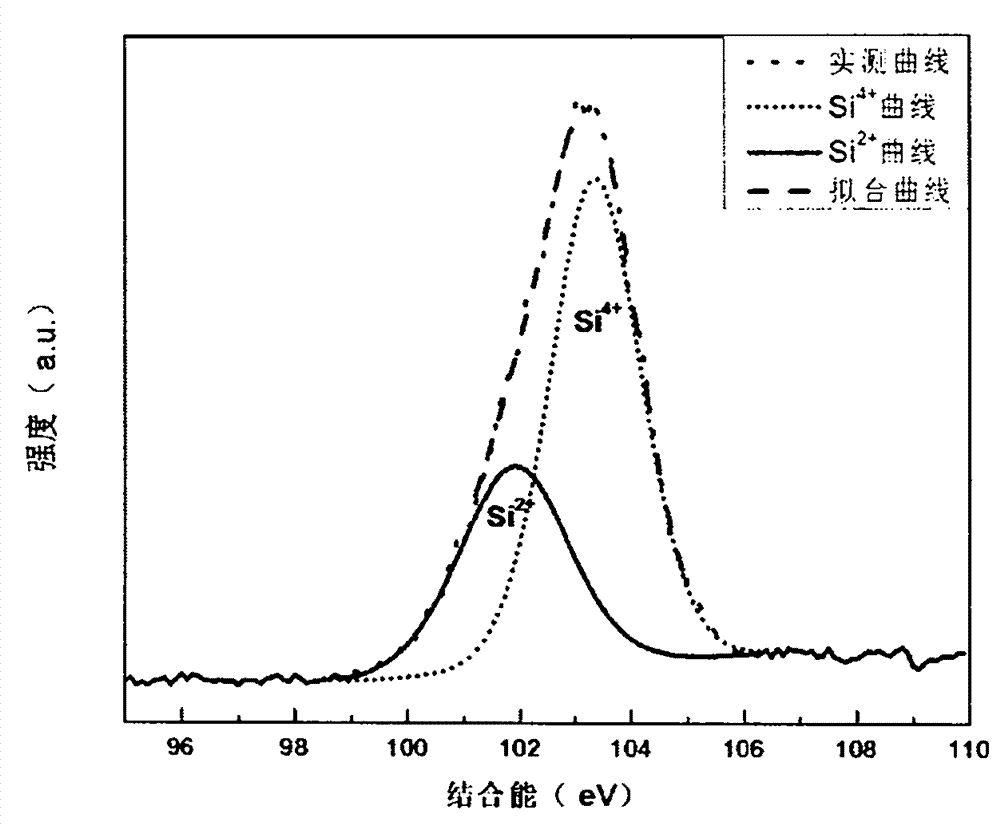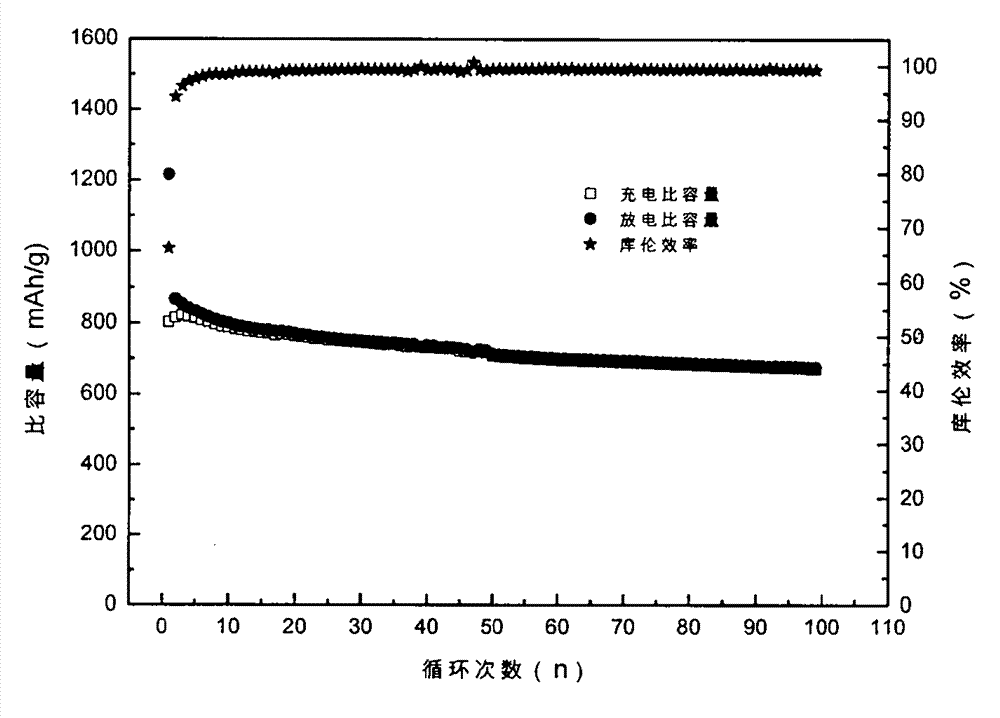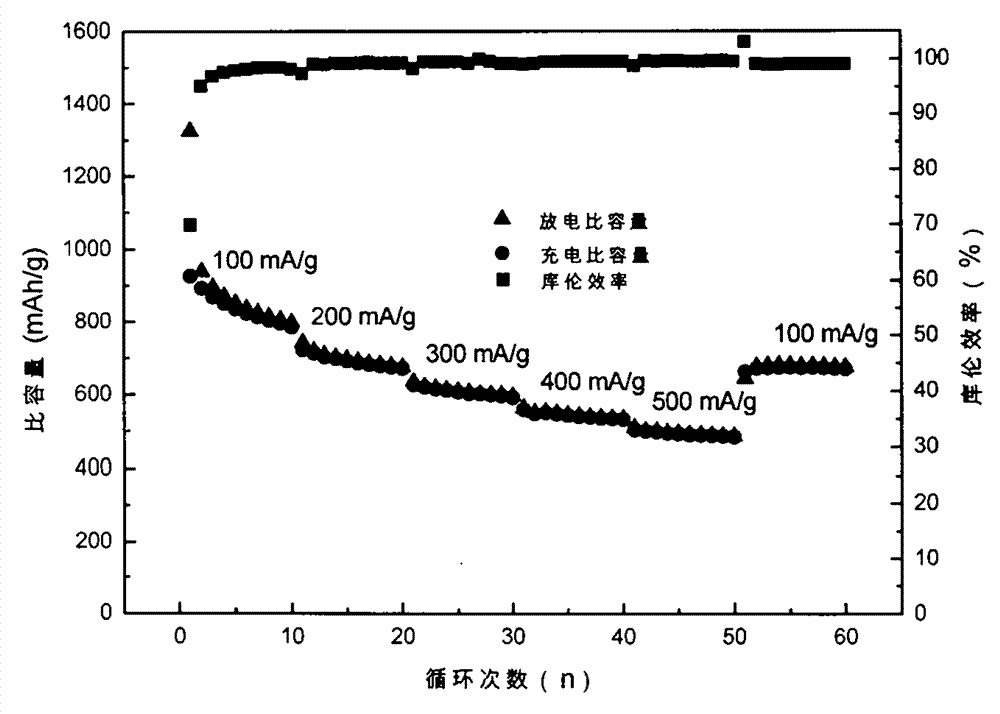Silicon oxide/carbon composite negative electrode material of lithium ion secondary battery and preparation method of silicon oxide/carbon composite negative electrode material
A technology for secondary batteries and negative electrode materials, applied in the field of silicon oxide/carbon composite negative electrode materials and their preparation, can solve problems such as poor cycle stability, and achieve the effects of long cycle life, increased specific surface area, and reduced oxygen participation
- Summary
- Abstract
- Description
- Claims
- Application Information
AI Technical Summary
Problems solved by technology
Method used
Image
Examples
Embodiment 1
[0024] 1) First, the precursor is prepared by the acid-base sol-gel method:
[0025] Glucose 2.48g was completely dissolved in water, and then 22.8ml of absolute ethanol was added. After stirring evenly by magnetic force, it was added to a 16.1% by volume ethyl orthosilicate ethanol solution. After mixing well, add 0.1 mol / L hydrochloric acid solution (the volume ratio of the added amount of hydrochloric acid solution to water is 1:10). After reacting at room temperature for 6 hours, 0.20ml of 0.1mol / L ammonia water was added dropwise until a stable gel was formed, aged at room temperature for 1 day, and dried at 70°C for 3 days to obtain a xerogel precursor.
[0026] 2) Secondly, the added carbon source and the original carbon source are mixed in a ball mill with a mass ratio of 1:1 for high-energy dry milling (the ball mill is a QM-3SP2 planetary ball mill produced by Nanjing University Instrument Factory, the same below), Wherein, the mass ratio of ball to material is 10:1...
Embodiment 2
[0035] 1) First, the precursor is prepared by the acid-base sol-gel method:
[0036]After 3.02 g of glucose was completely dissolved in water, 25.1 ml of absolute ethanol was added, and evenly stirred by magnetic force, then added to a 19.2% volume percent ethyl orthosilicate ethanol solution. After mixing well, add 0.1 mol / L hydrochloric acid solution (the volume ratio of the added amount of hydrochloric acid solution to water is 3:10). After reacting at room temperature for 10 hours, 0.24ml of 0.1mol / L ammonia water was added dropwise until a stable gel was formed, aged at room temperature for 2 days, and dried at 100°C for 2 days to obtain a xerogel precursor.
[0037] 2) Secondly, the added carbon source is mixed with the original carbon source by high-energy dry milling at a mass ratio of 1:1.2, wherein the mass ratio of balls to material is 5:1, and the dry gel precursor obtained above is ground , adding glucose and ball milling at 400 r / min for 6 h to obtain a precurso...
Embodiment 3
[0043] 1) First, the precursor is prepared by the acid-base sol-gel method:
[0044] 3.69 g of glucose was completely dissolved in water, and then 29.2 ml of absolute ethanol was added. After magnetically stirring evenly, it was added to a 24.4% volume percent ethyl orthosilicate ethanol solution. After mixing well, add 0.1 mol / L hydrochloric acid solution (the volume ratio of the added amount of hydrochloric acid solution to water is 5:10). After reacting at room temperature for 12 hours, 0.35ml of 0.1mol / L ammonia water was added dropwise until a stable gel was formed, aged at room temperature for 1 day, and dried at 80°C for 3 days to obtain a xerogel precursor.
[0045] 2) Secondly, the added carbon source is mixed with the original carbon source by high-energy dry milling at a mass ratio of 1:1.5, wherein the mass ratio of balls to material is 20:1, and the dry gel precursor obtained above is ground , adding glucose and ball milling at 500 rpm for 8 hours to obtain a pre...
PUM
| Property | Measurement | Unit |
|---|---|---|
| Charging capacity | aaaaa | aaaaa |
| Inverse capacity | aaaaa | aaaaa |
| Discharge capacity | aaaaa | aaaaa |
Abstract
Description
Claims
Application Information
 Login to View More
Login to View More - R&D
- Intellectual Property
- Life Sciences
- Materials
- Tech Scout
- Unparalleled Data Quality
- Higher Quality Content
- 60% Fewer Hallucinations
Browse by: Latest US Patents, China's latest patents, Technical Efficacy Thesaurus, Application Domain, Technology Topic, Popular Technical Reports.
© 2025 PatSnap. All rights reserved.Legal|Privacy policy|Modern Slavery Act Transparency Statement|Sitemap|About US| Contact US: help@patsnap.com



